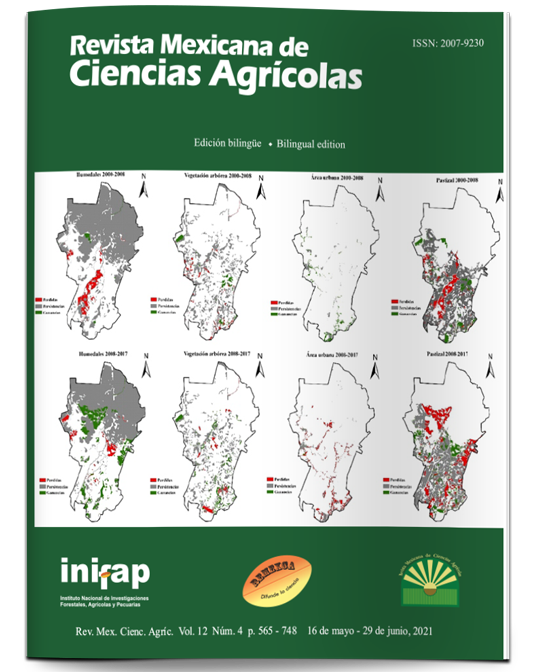Genotype environment interaction in fractions of dry matter of awn less bread wheats
DOI:
https://doi.org/10.29312/remexca.v12i4.2405Keywords:
AMMI model, environment genotype interaction, forage fractions, wheat without awnsAbstract
Cereals represent an important contribution to the diet of stabled cattle during the winter season, with oats being the most used species, although there are others with forage potential. The production of dry forage and its fractions in twelve awns less wheat genotypes was evaluated, including three commercial witnesses of other species, in order to determine the magnitude of the environment genotype interaction (IGA), as no information is available at the moment. A random complete block design with three repetitions in five test environments was used, sowing at a density of 120 kg ha-1 and doing traditional management of winter cereals. Forage evaluations were conducted between 112 and 118 days after planting. Dry forage of fractions was analyzed using the AMMI model. Of the IGA detected in the production of dry forage, the largest amount appeared in the stems, followed by that of leaves and finally that of spikes. The wheat genotypes G6, G1, G11 and G9 were rated as desirable along with barley as they exhibited good yield and stability. Oats were the least productive and stable. IGA appeared in both the production of total dry forage and its fractions, with the stems showing the greatest interaction. There are awn less wheats that are more desirable than oats for forage production and their fractions, which can be inserted into winter forage production schemes.
Downloads
Downloads
Published
How to Cite
Issue
Section
License
The authors who publish in Revista Mexicana de Ciencias Agrícolas accept the following conditions:
In accordance with copyright laws, Revista Mexicana de Ciencias Agrícolas recognizes and respects the authors’ moral right and ownership of property rights which will be transferred to the journal for dissemination in open access. Invariably, all the authors have to sign a letter of transfer of property rights and of originality of the article to Instituto Nacional de Investigaciones Forestales, Agrícolas y Pecuarias (INIFAP) [National Institute of Forestry, Agricultural and Livestock Research]. The author(s) must pay a fee for the reception of articles before proceeding to editorial review.
All the texts published by Revista Mexicana de Ciencias Agrícolas —with no exception— are distributed under a Creative Commons License Attribution-NonCommercial 4.0 International (CC BY-NC 4.0), which allows third parties to use the publication as long as the work’s authorship and its first publication in this journal are mentioned.
The author(s) can enter into independent and additional contractual agreements for the nonexclusive distribution of the version of the article published in Revista Mexicana de Ciencias Agrícolas (for example include it into an institutional repository or publish it in a book) as long as it is clearly and explicitly indicated that the work was published for the first time in Revista Mexicana de Ciencias Agrícolas.
For all the above, the authors shall send the Letter-transfer of Property Rights for the first publication duly filled in and signed by the author(s). This form must be sent as a PDF file to: revista_atm@yahoo.com.mx; cienciasagricola@inifap.gob.mx; remexca2017@gmail.
This work is licensed under a Creative Commons Attribution-Noncommercial 4.0 International license.



